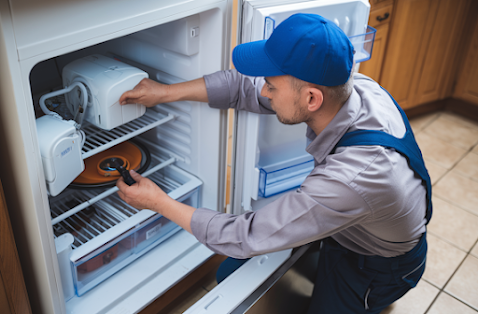A washing machine is an essential appliance in most homes. When it stops working, it can disrupt your routine and create unnecessary stress. Fortunately, not every issue requires a professional repair technician. In many cases, you can troubleshoot and fix common washing machine problems yourself. In this ultimate guide, we’ll walk you through everything you need to know about washing machine repair, from understanding how it works to solving frequent issues and knowing when to call an expert.
Understanding How a Washing Machine Works
Before diving into troubleshooting, it's helpful to understand the basic components of a washing machine:
Drum: Holds and spins the clothes during wash and rinse cycles.
Motor: Powers the drum and other moving parts.
Pump: Drains water out of the machine.
Valves: Control water flow into the drum.
Control Panel: Lets you select wash cycles and settings.
There are two main types of machines: top-load and front-load. While the basic operation is similar, the location of parts may vary.
A standard wash cycle includes filling the drum with water, agitating the clothes, draining the dirty water, rinsing, and then spinning to remove excess water.
Safety First: Precautions Before Repair
Always take these safety steps before attempting any repairs:
Unplug the machine and shut off the water supply.
Wear gloves to protect your hands.
Use appropriate tools and keep the area dry.
Refer to the user manual for part identification and specifications.
Never attempt electrical repairs if you’re not trained. If you see sparks, smell burning, or suspect an internal wiring issue, stop and call a professional.
Common Washing Machine Problems and How to Fix Them
Let’s look at some of the most frequent washing machine issues and how you can troubleshoot them.
1. Washing Machine Won’t Start
Possible Causes:
Power outlet is not working
Faulty door/lid switch
Blown fuse or tripped breaker
Fixes:
Plug another device into the outlet to test it.
Ensure the door is closed firmly. If it still doesn’t start, the door switch may need replacing.
Reset the breaker or replace the fuse.
2. Washing Machine Not Spinning
Possible Causes:
Unbalanced load
Broken drive belt
Faulty lid switch or motor
Fixes:
Stop the cycle, redistribute the clothes evenly, and restart.
Open the back panel and inspect the belt for wear.
Check if the lid switch clicks when closed. If not, it may need replacement.
3. Water Not Draining
Possible Causes:
Clogged drain pump or hose
Defective pump motor
Fixes:
Remove and clean the drain filter, usually located behind a small door near the bottom front.
Disconnect and check the drain hose for blockages.
If the pump is noisy or not working, consider replacing it.
4. Washing Machine Leaking Water
Possible Causes:
Loose hose connections
Damaged door seal (especially on front-loaders)
Cracked tub or pump housing
Fixes:
Tighten all hose connections.
Inspect the rubber door gasket for tears or mold buildup and clean or replace as needed.
If leaking persists from underneath, check for cracks and consult a technician.
5. Washing Machine Making Loud Noises
Possible Causes:
Foreign objects in drum
Worn drum bearings
Unbalanced load
Fixes:
Check for coins, buttons, or small objects in the drum or pump filter.
Listen for a grinding noise—this may indicate worn bearings.
Make sure the machine is level and the load is balanced.
6. Washing Machine Smells Bad
Possible Causes:
Mold or mildew buildup
Detergent residue
Standing water
Fixes:
Run a hot water cleaning cycle with vinegar or a washing machine cleaner.
Clean the rubber gasket, detergent drawer, and drum regularly.
Leave the door open after each wash to allow air circulation.
DIY Maintenance Tips to Prevent Issues
Routine maintenance can help avoid most problems. Here are some easy habits to keep your machine in top shape:
Clean the drum and gasket monthly.
Use the right detergent (especially for HE machines) and avoid overloading.
Inspect hoses for cracks and tighten connections regularly.
Run a maintenance cycle every 30-40 washes using washing machine cleaner or a vinegar-baking soda mix.
Keep the door open between uses to prevent mildew.
When to Call a Professional
While many problems can be fixed at home, some situations require expert help:
Persistent error codes that won't clear
Electrical issues or burning smells
Broken internal parts like the motor or control board
Drum not turning despite all other fixes
Trying to fix complex issues without proper knowledge may void your warranty or worsen the damage. When in doubt, consult a licensed appliance repair technician.
Conclusion
Your washing machine is a hardworking appliance, and like any machine, it needs occasional TLC. By understanding how it works and learning to troubleshoot common issues, you can save time, money, and hassle. With regular maintenance and a little DIY spirit, you can keep your washer running smoothly for years. Call Beach 2 Bay Repair Services, LLC
Remember: safety first, don’t rush repairs, and know when to call in the pros. Whether it’s a noisy spin cycle or a puddle on the floor, this guide helps you get back on track quickly.



